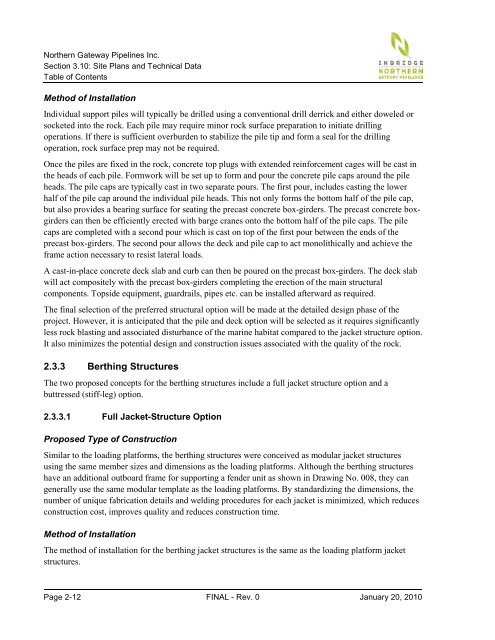Section 3.10: Site Plans and Technical Data - Rick Neufeld Comments
Section 3.10: Site Plans and Technical Data - Rick Neufeld Comments
Section 3.10: Site Plans and Technical Data - Rick Neufeld Comments
Create successful ePaper yourself
Turn your PDF publications into a flip-book with our unique Google optimized e-Paper software.
Northern Gateway Pipelines Inc.<br />
<strong>Section</strong> <strong>3.10</strong>: <strong>Site</strong> <strong>Plans</strong> <strong>and</strong> <strong>Technical</strong> <strong>Data</strong><br />
Table of Contents<br />
Method of Installation<br />
Individual support piles will typically be drilled using a conventional drill derrick <strong>and</strong> either doweled or<br />
socketed into the rock. Each pile may require minor rock surface preparation to initiate drilling<br />
operations. If there is sufficient overburden to stabilize the pile tip <strong>and</strong> form a seal for the drilling<br />
operation, rock surface prep may not be required.<br />
Once the piles are fixed in the rock, concrete top plugs with extended reinforcement cages will be cast in<br />
the heads of each pile. Formwork will be set up to form <strong>and</strong> pour the concrete pile caps around the pile<br />
heads. The pile caps are typically cast in two separate pours. The first pour, includes casting the lower<br />
half of the pile cap around the individual pile heads. This not only forms the bottom half of the pile cap,<br />
but also provides a bearing surface for seating the precast concrete box-girders. The precast concrete boxgirders<br />
can then be efficiently erected with barge cranes onto the bottom half of the pile caps. The pile<br />
caps are completed with a second pour which is cast on top of the first pour between the ends of the<br />
precast box-girders. The second pour allows the deck <strong>and</strong> pile cap to act monolithically <strong>and</strong> achieve the<br />
frame action necessary to resist lateral loads.<br />
A cast-in-place concrete deck slab <strong>and</strong> curb can then be poured on the precast box-girders. The deck slab<br />
will act compositely with the precast box-girders completing the erection of the main structural<br />
components. Topside equipment, guardrails, pipes etc. can be installed afterward as required.<br />
The final selection of the preferred structural option will be made at the detailed design phase of the<br />
project. However, it is anticipated that the pile <strong>and</strong> deck option will be selected as it requires significantly<br />
less rock blasting <strong>and</strong> associated disturbance of the marine habitat compared to the jacket structure option.<br />
It also minimizes the potential design <strong>and</strong> construction issues associated with the quality of the rock.<br />
2.3.3 Berthing Structures<br />
The two proposed concepts for the berthing structures include a full jacket structure option <strong>and</strong> a<br />
buttressed (stiff-leg) option.<br />
2.3.3.1 Full Jacket-Structure Option<br />
Proposed Type of Construction<br />
Similar to the loading platforms, the berthing structures were conceived as modular jacket structures<br />
using the same member sizes <strong>and</strong> dimensions as the loading platforms. Although the berthing structures<br />
have an additional outboard frame for supporting a fender unit as shown in Drawing No. 008, they can<br />
generally use the same modular template as the loading platforms. By st<strong>and</strong>ardizing the dimensions, the<br />
number of unique fabrication details <strong>and</strong> welding procedures for each jacket is minimized, which reduces<br />
construction cost, improves quality <strong>and</strong> reduces construction time.<br />
Method of Installation<br />
The method of installation for the berthing jacket structures is the same as the loading platform jacket<br />
structures.<br />
Page 2-12 FINAL - Rev. 0 January 20, 2010
















